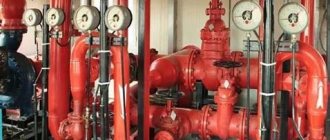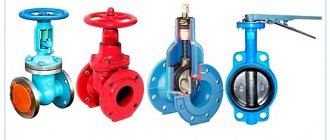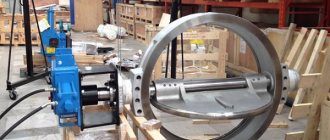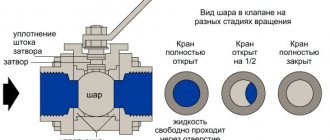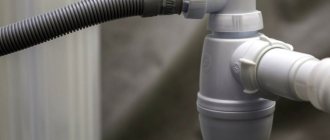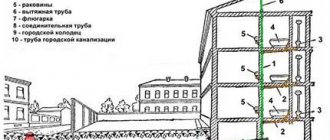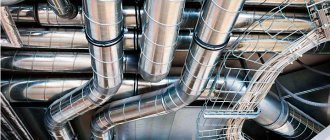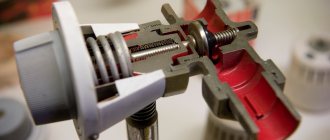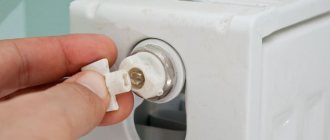What is it and where are they used?
Gate valves are a common type of shut-off valves used to completely block the movement of the medium for carrying out repair work in the system or maintenance of plumbing fixtures. They are equipped with almost any pipelines with a diameter from 15 mm to 2 m in hot/cold water and oil products supply systems operating with constant high-speed movement of the medium under pressure up to 25 MPa. They have a relatively simple design, short overall length, low hydraulic resistance, are suitable for operation in conditions of varying complexity, and can be controlled manually or using an electric drive.
To shut off gas equipment, Ludlo type valves with a retractable spindle are most often installed.
If valves are mainly used as shut-off devices, then water stops perform both functions of pipeline fittings. They have the ability not only to stop the flow, but also to regulate the flow of water. However, they are limited in terms of the permissible operating pressure - up to 2.5 MPa.
How to select a crane?
When purchasing a faucet, take into account a number of nuances:
- purpose of the locking element - the handle is painted in a certain color, based on the nature of use; devices for gas pipelines are designated black or yellow, for cold water - blue, hot - red;
- installation method - in household networks, a faucet mounted on threaded connections; if the working environment involves acidic or alkaline compounds, liquids heated to high temperatures, weld fittings are used.
Rice.
11. Appearance of a ball valve for gas The product is selected according to the following criteria:
- nominal diameter - depends on the size of the pipe; in everyday life, shut-off valves from 15 to 50 mm are used;
- type of connection - a product with threaded fixation with union nuts (“American” ones) is more convenient;
- maximum operating pressure - this indicator is marked on the body; taken according to the characteristics of the network, selecting a shut-off element with a reserve;
- body material - take into account the composition of the working environment, the type of pipeline; brass or plastic taps are used for water supply;
- the quality of the shutter element - assessed visually, by the absence of jamming and unevenness during operation;
- release date - you should not buy a product that has been in storage for five years or more;
- brand – preference is given to products of well-known brands.
The purchased faucet is carefully inspected to exclude external defects and damage - chips, nicks, cracks on the body, deformation of elements. Check the completeness of the goods.
When buying a durable and expensive brass faucet, it is important to exclude a fake - a cheap silumin device. The actual product is determined by its weight. It is necessary to request from the seller certificates and passport documentation confirming the quality of the products.
Errors when purchasing will lead to the fact that the product will have to be urgently replaced when the owner is not ready for this situation.
Design and principle of operation
The design of a water valve consists of three main components:
- A housing with a lid, in the cavity of which locking parts are located and a certain part of the working substance is held under pressure. The body is a hollow, solid or collapsible structure made of steel, cast iron or non-ferrous metals. All its surfaces are protected from corrosion by epoxy resin. The housing has two pipes (inlet and outlet) with which the device is connected to the pipeline.
- A locking unit consisting of two seats and a bolt. The seats have a parallel or angular arrangement with respect to each other; when the valve is actuated to close, the sealing part is pressed against their sealing surfaces. Centering of the lock is ensured by guides in the form of vertical cylinders with grooves, made of wear-resistant plastic or being a protruding part of the inner surface of the body. The lock itself, depending on the modification of the valve, can have the shape of a wedge, one or two disks;
- Control node. It consists of a screw rod (spindle), a flywheel and a threaded bushing, with the help of which the torque is converted into translational movement of the shutter part. The running unit can be located in the upper part of the cavity of the device body or located outside it. The hole through which the spindle exits the housing is sealed with a special seal that operates on the principle of a bellows or oil seal.
The principle of its operation is as follows:
- the flywheel is driven manually or electrically;
- the force is transmitted through a threaded connection to the rod, which moves the valve along the guides perpendicular to the flow;
- the shut-off part is pressed tightly against the seats and stops the movement of fluid flow in the pipeline.
To open the valve, the flywheel is turned in the opposite direction.
Ball Valves
A ball valve is a shut-off element with a shutter device in the form of a ball with a through hole, enclosed in a body, with a tight fit to the surfaces of the seat.
Rice. 7. Appearance of the ball valve
The ball valve consists of the following components:
- all-welded or collapsible body;
- rod with o-ring seals;
- a ball-shaped shutter with a mirror-polished surface;
- seat seals sealing the connection;
- handles in the form of a butterfly or a lever secured to the rod with a nut.
The operating principle is based on reversing the hole of the valve element, changing the location of the through hole in the ball relative to the flow of the working medium.
Rice. 8. Operating principle of a ball valve
Water supply valves
In a water pipeline valve, the shut-off element is made in the form of a disk, the diameter of which is equal to the size of the internal diameter of the pipe. When the valve opens and closes, the disk rotates around an axis perpendicular to the direction of flow.
The valve body has a shortened cylindrical shape, can be dismounted or monolithic (all-welded design). It is made from cast iron alloys, different types of steels, non-ferrous metals, and composite polymers. In its cavity there is a locking organ, consisting of a movable part - a flat or biconvex disk and a fixed part - the saddle. Elastic rubber rings are used as seals.
Maintenance
Considering that taps are installed at the inlet and outlet of equipment, the frequency of maintenance is tied to the timing of checking these devices.
During the above work, the functioning of the shutter element is checked, turning in both directions. The valve must completely close the line, with the rod moving freely. The fittings are inspected visually for defects and damage - chips, cracks, deformations, leaks of the working medium.
Check the fastening of the handle. If necessary, tighten the nut securing the lever or butterfly. If you use a valve with a loose control, this may cause the stem journal to break.
If the device is used outdoors, the pressure on the shut-off element is turned off during the winter, and the shutter is moved to the open position to prevent the liquid from freezing inside the housing.
Rice. 13. The tap is inspected to ensure there are no external leaks.
If there is a drive mechanism, the gearbox is serviced by replacing (adding) lubricant and tightening fasteners. The frequency of drive maintenance is no less than every 100 - 120 operating cycles.
The fittings need to be replaced when the following signs appear:
- loss of external sealing of the housing;
- valve leakage exceeding the permissible value;
- the occurrence of cracks and deformations that pose a risk of destruction of the device or interfere with its normal operation.
For replacement, a similar element is selected based on operating characteristics and dimensions.
If the faucet breaks down within the warranty period, the product must be replaced with a new one, unless the failure is associated with the following circumstances:
- violation of the operating rules specified in the valve data sheet;
- damage during transportation - these defects are checked upon purchase; otherwise, cracks and other deviations from normal condition can be explained by improper handling of the crane by the owner;
- use in conditions for which the valves are not designed, with excess pressure, violation of the prescribed composition and characteristics of the working environment;
- unauthorized interference with the design of the device.
The decision to replace the product within the warranty period is made by the manufacturer, subject to the provision of original passport documentation.
Types and classification of water valves
According to the design of the shut-off element, valves for water supply systems are divided into:
- wedge;
- parallel;
- gate;
- hose
Wedge valves are equipped with a cone-shaped gate, which, in the “closed” position, fits tightly into the space between the seats. The wedge can be of different types:
- rigid, having the shape of a solid plate narrowed towards the bottom. It smoothly descends into the lower part of the device and blocks the passage holes of the seats in a perpendicular direction, thus interrupting the movement of the working medium. A rigid wedge reliably locks the passage hole, but is more susceptible to rust and is more difficult to fit to the saddles. Therefore, in such devices there is a danger of jamming and difficulties arise in lifting the wedge during sudden temperature changes;
- double-disk - consisting of two disks that are movably fastened together at an angle to each other. When the valve is activated to close, both elements rotate relative to each other and close the passage holes in the seats, pressing tightly against their sealing surfaces. When opened, they move away from the seats, freeing passage for the working substance. This design of the shut-off element provides a good level of tightness, reduces the risk of jamming and increases the service life of the entire device;
- elastic, the two disks of which are connected to each other by an elastic rubber part. It is capable of bending under the influence of water pressure, thus providing tighter pressure to the sealing materials of the seats. Valves with a rubber wedge require less effort to operate and have smooth passage surfaces that reduce friction and wear on the valve elements.
Parallel valves include devices in which the sealing surfaces of the shut-off or control element are located in parallel planes to each other.
For stove chimneys, gate valves are used, the design of which includes a frame and a metal plate with a handle. When the valve is opened, the plate moves out of the frame; when closed, it returns to its original position.
Application of shut-off valve
- Valves are used in virtually all fluid services such as air, fuel gas, feed water, steam, lubricating oil, hydrocarbons and all other media.
- Some specialty valves are used in slurry and powder products such as knife valves.
Advantages of gate valves:
- The valve provides good pressure drop during operation is significantly less;
- Most of the gate valves can be used as bi-directional;
- They are suitable for high pressure and temperature applications and require less maintenance.
Disadvantages of gate valves:
- They cannot be used for flow control;
- The valve is running slowly. Opening and closing takes a long time, which is also good because it reduces the likelihood of impacts;
- When partially opened, it creates vibration and noise;
- Repairs such as lapping and sanding seats are more difficult due to limited access.
Gate valve selection criteria
To correctly select a water valve, it is necessary to perform a thorough analysis of the initial requirements for its technical characteristics, as well as compare prices for products from different manufacturers.
This analysis is performed in the following sequence:
- determination of the purpose and operating conditions of the valves (properties of the working medium, the value of the maximum operating pressure and temperature range);
- determination of the nominal size of the conditional diameter (DN);
- choosing a device control method;
- selection of material for body parts;
- clarification of the function (locking or regulation);
- choice of design modification of the product;
- final determination of the geometric parameters of the device (construction length and height, dimensions of connecting ends, method of connection to the impulse line, number of fastening elements, etc.);
- selection of the appropriate model according to the range of valves produced.
Cast iron fittings for heating and water supply systems have recently been used less frequently; mainly steel devices are used here. Cast iron shut-off valves are often installed in sewers, in systems for supplying compressed air, steam and bulk materials.
Minuses
In the manufacture of shut-off valves, cast iron is often used to reduce costs; such designs have the following disadvantages:
- The high weight of the valves makes it difficult to install units with large pipeline diameters—several workers or special lifting equipment may be needed to hold the massive part. For example, the weight of a cast iron constipation with a nominal bore of 1600 mm. According to GOST 9698-86 it is 10025 kg.
- Cast iron is a corrosion-unresistant material; over time, its inner surface rusts, becomes covered with shells and limescale - this leads to a failure of sealing when the flow is blocked.
- Another disadvantage of cast iron is its fragility, which leads to irreversible damage to the product under strong impacts.
- A cheap gland seal with packing, which is used in budget cast iron products, is not sufficiently tight compared to modern mechanical seals - during its operation, leaks of the transported substance often occur.
Rice. 5 Operating principle of a wedge-type valve
Pipeline connection and installation
The connecting ends of the valves can be flanged, coupling or welded. The method of carrying out the installation process depends on this factor and the type of pipe in the system.
Connection to metal water pipes
Installation of valves in a water supply system made of metal pipes is carried out as follows:
- cut out a section of pipe at the installation site equal in length to the size of the device body;
- clean the edges;
- depending on the type of connection to the process of the selected valve, either threads are cut on the edges of the pipes or counter flanges are welded to them;
- seal the joints: flanged joints are sealed with rubber rings, threads are sealed with linen thread;
- fix the valve on the pipeline: the flanges are fastened with bolts and washers or the connecting pipes are screwed onto the prepared thread.
Installation in a plastic pipe system
When installing a valve on a plastic pipe:
- cut out a section of pipe of the required length;
- both ends are put on the nozzles of the welding machine heated to 260ºС;
- after heating, the connecting pipes of the device are inserted into them;
- keep the joints stationary for several minutes until the plastic has completely hardened.
Features of installation on chimneys
The stove valve is installed on the chimney at the stage of its construction:
- lay a row of bricks according to the order;
- cut out a recess on top of the brick that matches the thickness of the valve frame and a groove on the side for the handle;
- place the gate in the prepared recess in cement mortar;
- lay the next row of bricks.
Marking
The marking contains:
- manufacturer's trademark;
- mark of conformity and certification body code;
- conditional pressure PN, MPa;
- nominal diameter DN;
- brand of body material for version UHL1 (on the plate);
- serial number and date of manufacture;
- weight of the valve without electric drive (on the plate);
- Quality Control Department stamp (on the plate);
- the inscription “Made in …” (on the plate).
The actual value of the carbon equivalent "Ce" of the body material (on the inner surface of one of the pipes or the counter flange).
The valve is supplied in one cargo piece, in a horizontal position on pallets with the passage holes of the pipes closed with plugs.
When the valve is supplied complete with an electric actuator, shipment is made in two cargo units.
Counter flanges (for versions with counter flanges) are shipped assembled with the valve.
Some installation recommendations and useful tips
There are a number of rules that must be followed during installation, namely:
- Shut-off valves should not, at the time of installation and upon completion of installation, experience external loads, including those from the pipeline;
- the installation site must be accessible for further inspection and maintenance;
- when installing on a horizontal section of the pipeline, it is prohibited to place the device with the flywheel down; on a vertical section, the position of the flywheel can be any;
- Do not disassemble the device under pressure;
- before installing the valve, steam the internal surfaces with hot water followed by drying;
- It is advisable to place a magnetic resonance filter in front of the valve;
- when opening and closing the valve, the steering wheel should be turned smoothly, avoiding jerking;
- tighten the oil seal bushing in a timely manner;
- Pressure testing of the pipeline should be carried out with the valves open.
If you have any useful tips for installing water valves, please share them in the comments. Subscribe to our channel, share your experience with us, as well as on social networks.
(
1 ratings, average: 5.00 out of 5)
Maintenance
To eliminate malfunctions and the danger of emergency failure, periodic inspections of the fittings are carried out, checking the operation of the device. The frequency of inspections, including maintenance, is determined by the system adopted at the enterprise and the manufacturer’s conditions given in the passport.
Maintenance includes the following operations performed taking into account the technical condition of the element:
- lubricating the spindle threads with grease, in accordance with the manufacturer’s operating instructions;
- tightening the stuffing box seal by tightening the nuts that tighten the bushing;
- adding or replacing the oil seal - if the bushing is lowered to the lower position and the tightness is not maintained;
- lubricating the threaded connection between the spindle and the nut.
When tightening and replacing the oil seal, turn off the supply of the working medium, removing pressure from the valve.
The minimum frequency of maintenance is every six months.
Rice. 6. Valve maintenance
To comply with safety measures, it is prohibited:
- tighten, add, change stuffing box seals while applying pressure to the locking element;
- tighten the oil seal by hitting the bushing;
- dismantle and repair the valve without removing the pressure in the line;
- exceed the pressure when pressing the pipeline, established by the limiting characteristics of the fittings.
Personnel performs maintenance of locking elements using special clothing and protective equipment required by labor protection standards.
Characteristics
Cast iron flanged valves are a popular product that is used on highways for various purposes. They produce products with different diameters, which can vary from fifty to four hundred and twenty millimeters. The flanged valve 30ch6br is designed to operate at a pressure of 10 bar, temperature range up to two hundred degrees. Devices with large diameters are often equipped with an electric drive, which makes it possible to control the system remotely. Gate valves 30ch6br can be installed in hard-to-reach areas of the pipeline. According to the type of control, flange elements are divided into those that are controlled manually or using a special electric drive. It is advisable to use manual control for small diameters, and in other cases, electric control. The price of the valve 30ch6br on the website is indicated in rubles. To place an order for the purchase of flanged valves, you need to call the phone number listed on the website.
